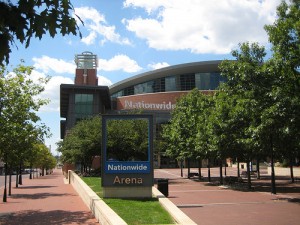
Thursday’s release of a report commissioned by the Columbus Chamber of Commerce to evaluate options for establishing the long term financial viability of the Columbus Blue Jackets, and their home in Nationwide Arena, was greeted by predictable measures of hand-wringing, dramatic proclamations and dire predictions. The report has already been put to a variety of uses by online commentators, ranging from serving as another example of big market vs. small market disparity in the NHL, to representing hope for previously abandoned Canadian cities still lusting after a new franchise. However, for those closest to the situation, and to those who actually read it carefully, the report represents simply another calculated, measured step in the process.
To briefly provide some historical context, the current series of events began in early June of this year, when the club released analysis completed by the John Glenn School of Public Affairs, documenting the multi-billion dollar impact that the Blue Jackets, Nationwide Arena and the surrounding Arena District have provided to the local market since the Blue Jackets commenced play in the 2000 – 2001 season. At the same time, they released the results of studies completed by the NHL and a related consulting firm, noting that the Columbus market, and the club, were financially sound, but that the club was unfairly burdened by the terms of its lease arrangement for the Arena and the absence of revenue streams, such as naming rights, parking fees and luxury box fees, that other similarly situated teams enjoyed.
The release of these studies was coupled with the disclosure that the club had been experiencing yearly operating losses of millions of dollars. Ownership indicated that these losses were not sustainable over the long term, and expressed the desire to find a solution. Unfortunately, one possible solution, involving an increase in the tax on alcohol and cigarettes, was prematurely disclosed by opposing lobbyists. Initial reaction from the public and local government was negative, sending all sides back to the drawing board. Representatives from the Blue Jackets, Nationwide Insurance, and Franklin County entered into discussions, and the decision was made to have an independent evaluation of potential options. The Chamber of Commerce agreed to fund such a study, and retained Dr. Stephen Buser, Professor Emeritus of the Fisher School of Business at Ohio State, to perform the study. It was that study that was released on Thursday. The purpose of the study was not to make recommendations, but merely outlining potential options for resolution of the situation in the long run.
Buser’s analysis confirms much of what the Glenn reports had already established – namely that the arrival of the Blue Jackets and the construction of Nationwide Arena had been an economic boon to the City of Columbus, Franklin County and the citizens at large. Buser notes that communities such as Edmonton and Kansas City were using the Columbus as a model of a top flight arena and a vibrant surrounding business and entertainment district. Conservative estimates place the increase in tax revenue alone at $30 million annually, with 50% of that number going to the State of Ohio, and the balance split evenly between the city and county. That number is expected to double over the next ten years, assuming the Blue Jackets and the Arena remain.
Ironically, it was the prospect for an economic revival of an area previously known only for the abandoned State Penitentiary that originally created the conditions that have ultimately led to the financial situation existing today. When the plan for a multi-purpose arena to host an expansion NHL franchise, combined with a surrounding entertainment and business district, was presented to voters in the Spring of 1997, the cynical central Ohio electorate defeated the proposal , not really believing that the trick could be pulled off. That defeat forced the hand of local businessmen, led by the late John McConnell and former Nationwide CEO Dimon McFerson. McConnell stepped up and took the lead in funding the team, while Nationwide funded the Arena. With the exception of infrastructure improvements for ingress and egress made by the City, and related tax abatements provided to Nationwide, the economic revival enjoyed by the community has been largely without taxpayer cost.
The downside of that arrangement is that it dramatically increases the burden on the private sector entities involved in the enterprise. To make economic sense, Nationwide retained many of the revenue streams normally made available to other NHL franchises – such as the naming rights, parking and a measure of luxury box revenue. In addition, despite the fact that the club had no ownership interest in the Arena, which could at least impact the balance sheet, the Blue Jackets are responsible for the actual operation of the arena, and pay Nationwide for their tenancy, both costs that most other teams do not have. Being a small-market town, and having competition from the nearby Schottenstein Center at Ohio State, operations for non-hockey events lose approximately $4 – $5 million per year, and a similar amount is paid for utilization of the arena. Add in another $2 million per year that would otherwise be coming in for naming rights, and the Blue Jackets are at a $12 million annual disadvantage over other teams. Buser observes that hockey operations themselves are approximately break-even, when NHL revenue sharing is considered.
Those unfamiliar with the situation are quick to jump to conclusions and compare Columbus to the catastrophic losses seen in Phoenix. However, the two situations are not comparable. While significant, and not tolerable over the long term, the $12 million revenue gap seen in Columbus is a drop in the bucket compared to the red ink bleeding in Arizona. Unlike the situation faced by the Coyotes, the Columbus market is fundamentally strong, , the team is on the rise, and the club itself has sound, committed management. Ownership has not threatened a move, and has indeed deflected any talk of a move in favor of deliberate consultation and collaboration toward finding a solution. However, as Buser notes, the losses cannot continue, and without a long term solution, the team could leave. Buser lays out over 20 possible paths for finding a solution to the problem, ranging from the less-likely private scenarios, to more elaborate public financing solutions. 
After the release of the report, the Franklin County Commissioners released the following statement:
We appreciate the efforts undertaken by the Chamber and Dr. Buser to provide the central Ohio community with a current assessment of the Arena District and the Columbus Blue Jacket’s (sic) team operations. This report provides a vehicle for public discussion.
The Arena District, home to the county-owned Huntington Park, is an engine of economic development. We recognize that since 2000, the Columbus Blue Jackets and Nationwide Arena have contributed $2 Billion to the central Ohio economy.
These are tight economic times and it will take the time and effort of the entire community to determine what’s best for central Ohio.
Shortly after that statement was released, I spoke with Commissioner John O’Grady concerning his analysis of the report and the next steps from the County’s perspective. He characterized the report as “a great document that we can use as a tool to craft a solution.” He noted that there was “no question” concerning the substantial economic benefit that the Blue Jackets and Nationwide Arena had brought to the community, and believed that the County, City and State governments all have a vested interest in making a solution happen. O’Grady observed:
Nobody (in the public) could have predicted the degree of success that we have seen with the Blue Jackets and the Arena District, and the tremendous economic impact that these have had in the community. . . My personal belief is that a public-private partnership is the right answer.
When questioned about the rather tepid tone of the Commissioners’ press release O’Grady noted that the release represented the three commissioners, not just the view of any one individual:
While I know that all three County Commissioners understand the magnitude of this issue . . . our individual approaches (to the problem) might vary.
O’Grady conceded that the failure to keep the Blue Jackets would be “devastating” to the local economy and the community, and expressed confidence that a solution will be found. Coach Ken Hitchcock echoed that sentiment, noting that he had seen similar issues throughout the United States and Canada, and that solutions are almost always found.
It seems likely that the ultimate solution will involve a combination of approaches. Buser noted the success of Nashville’s model, where the government owns the Arena, and the Predators retain some of the key revenue items. And something similar could be orchestrated here. Combined with an increase in hotel taxes and a potential “special district” designation, there are a number of vehicles available to the participants. As intended, the Buser Report lays out those options in admirable detail. Whatever solution is chosen, it can be reasonably anticipated that every effort will be made to avoid a public tax impact requiring voter approval. The grumpy Columbus constituency reacts poorly to funding requests, even for schools, and to count on an exception here could be risky. Ironically, just this week Ohio voters approved the construction of casinos in Cleveland, Cincinnati, Toledo and Columbus. Notwithstanding the fact that the tax revenue derived could be a boon to local government, Columbus was the only one of the four targeted communities where a majority voted against the initiative. The casinos will be built, but the message should be noted.
Reactionary responses notwithstanding, today’ report does not represent a setback, nor is it the culmination of an effort. Instead, as intended, it forms the foundation for the serious building of a consensus solution that will make sense for all concerned. In the meantime, Coach Hitchcock needs to focus on continuing to win hockey games.